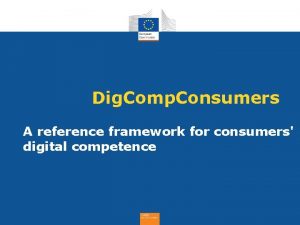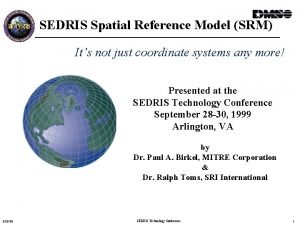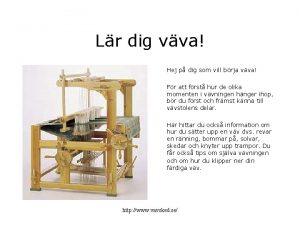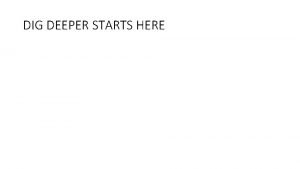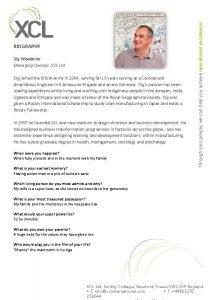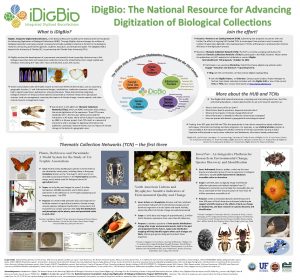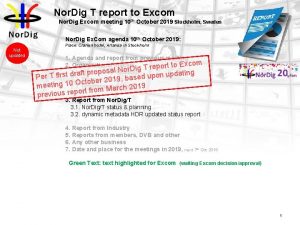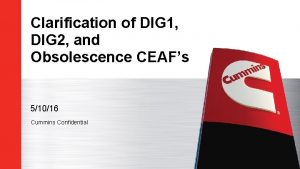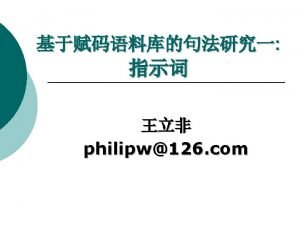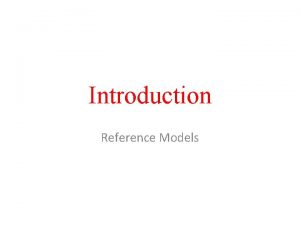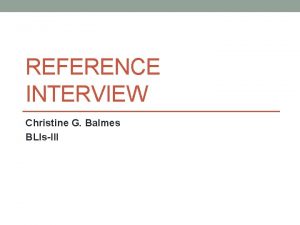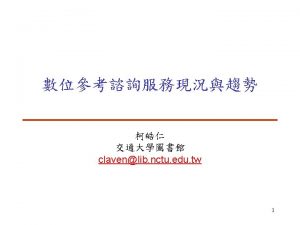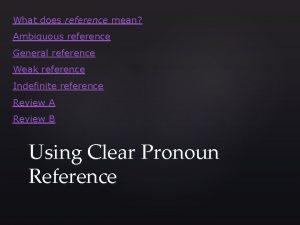Dig Comp Consumers A reference framework for consumers














- Slides: 14

Dig. Comp. Consumers A reference framework for consumers' digital competence

From Dig. Comp to Dig. Comp. Consumers • What is Dig. Comp? • Why Dig. Comp. Consumers? • How is Dig. Comp used?

A digital competence reference framework • In 2014, almost 40% of EU population had insufficient digital skills • A common understanding: which digital skills? • DIGCOMP reference framework : Identify and describe key components of Digital Competence in terms of knowledge, skills and attitudes.

Digcomp 1. 0 Dig. Comp 2. 0

1. 2 Evaluating data, information and digital content To analyse, compare and critically evaluate the credibility and reliability of sources of data, information and digital content. To analyse, interpret and critically evaluate the data, information and digital content.

WHY Dig. Comp. Consumers • Empowerment survey: consumers with digital skills are better informed and more empowered • Understand digital marketing & profiling, comparison tools, user reviews etc. • Use "digital" to promote consumer education & speak language of educators •

Dig. Comp. Consumers • Consumer digital competence is the competence consumers need to function actively, safely, and assertively in the digital marketplace. - only specific competences in digital environment

Dig. Comp. Consumers 1. 1 Browsing, searching, and filtering information Browsing, searching and filtering information on goods and services 1. 2 Evaluating information and data Evaluating and comparing information on goods and services Recognising and evaluating commercial communication and advertisement 1. 3 Storing and retrieving information and data Interacting through digital technologies 2. 1 2. 2 2. 3 Sharing information and content through digital technologies Engaging in citizenship through digital technologies Interacting in the digital marketplace to buy and sell Sharing information with other consumers in the digital marketplace Participating in collaborative economy platforms Asserting consumers’ rights in the digital marketplace Managing payments and finances through digital means 2. 4 2. 5 2. 6 3. 1 3. 2 3. 3 3. 4 4. 1 4. 2 4. 3 4. 4 5. 1 5. 2 5. 3 5. 4 Collaborating through digital technologies Netiquette Managing digital identity Developing content Integrating and re-elaborating content Copyright and licences Programming Protecting devices Protecting personal data and privacy Protecting health Protecting the environment Solving technical problems Identifying needs and technological responses Creatively using digital technologies Identifying digital competence gaps Managing digital identity and profile in the digital marketplace Understanding copyrights, licences, and contracts of digital goods and services Protecting personal data and privacy Protecting health and safety Considering responsible and sustainable consumption in digital markets Identifying digital consumer competence gaps and limits

1. 2. Evaluating and comparing information on goods and services – Learning outcomes • - To compare and critically evaluate the reliability of digital sources of information on goods and services. • - To compare and critically evaluate information on goods, services, purchasing terms and conditions related to the digital marketplace. • - To compare commercial offers using comparison tools, websites and channels.

1. 2. Evaluating and comparing information on goods and services – examples • Knowledge : Understand that not all information online on goods and services is reliable or complete • Skills : Able to use online price comparison tools or tools that compare quality and price • Attitude : Values that making informed choices implies comparing offers from different providers

Pre-purchase Competences • 1. 2. Browsing, searching and filtering information on goods and services • 1. 2 Evaluating and comparing information on goods and services • 1. 3 Recognising and evaluating commercial communication and advertisement • 1. 4 Managing digital identity and profile in the digital marketplace • 1. 5 Considering responsible and sustainable consumption in digital markets •

Areas Competences 1 Pre-purchase 1. 1 Browsing, searching and filtering information on goods and services To search for and access information related to goods and services using digital tools. To identify and select the information needed regarding goods, services and transactions options. 1. 2 Evaluating and comparing information on goods and services To compare and critically evaluate the reliability of digital sources of information on goods and services. To compare and critically evaluate information on goods, services, purchasing terms and conditions related to the digital marketplace. To compare commercial offers using comparison tools, websites and channels. 1. 3 Recognising and evaluating commercial communication and advertisement To recognise and critically evaluate different marketing and advertising methods and activities in digital environments. To recognise how online advertising and commercial communication can influence one’s choices as a consumer. 1. 4 Managing digital identity and profile in the digital marketplace To understand that one’s profile as a digital consumer can be built, modified, manipulated and exploited. To manage the data that one generates through different digital tools and services. To create and manage one or multiple digital identities (e. g. personal, professional) to maximize the benefits of the digital marketplace. 1. 5 Considering responsible and sustainable consumption in digital markets To consider that one’s behaviour as a digital consumer affects the community, society and environment. To use digital technologies to make socially and environmentally responsible choices. 2 Purchase 2. 1 Interacting in the digital marketplace to buy and sell To use digital marketplaces for buying and selling goods and services. 2. 2 Participating in collaborative economy platforms To understand participate in sharing or collaborative economy platforms. To engage in micro-selling practices (P 2 P). To recognize different and new digital business models. 2. 3 Managing payments and finances through digital means To safely make digital payments and use online financial services. To use digital technologies to keep track of and manage one’s personal budget. 2. 4 Understanding copyrights, licenses, and contracts of digital goods and services To understand act upon rights and responsibilities related to copyright, licenses and contracts that apply to digital content, goods, and services. 2. 5 Managing personal data and privacy To protect personal data and privacy in the digital marketplace. To understand how to share identifiable personal information while protecting oneself and others from risk. To know that digital services provide a “Privacy policy” to inform how personal data is used and acting upon this information. 2. 6 Protecting health and safety To understand avoid physical and psychological health and safety risks related to information, goods and services in the digital marketplace. 3 Post-purchase 3. 1 Sharing information with other consumers in the digital marketplace To share reviews, knowledge, advice and experiences in the digital marketplace. 3. 2 Asserting consumers’ rights in the digital marketplace To know one’s rights and responsibilities as a digital consumer. To assert one’s rights before and after purchase, and to know how to solve problems and disputes. 3. 3 Identifying digital consumer competence gaps and limits To understand gaps and limits of one’s digital consumer competences. To keep updated with the developments in the digital market place that have an

How to use Dig. Comp. Consumers? • 1 - mapping and identifying gaps in consumer education material (Consumer Classroom, VZBV • 2 - Dialogue between consumer policy and education professionals about digital consumer education in schools • 3 - Surveys for benchmarking digital competences of consumers and evidence base for digital consumer education need and impact •

Publications • Summary report as JRC Science for Policy Report • https: //ec. europa. eu/jrc/en/digcompconsumers • Full report on DG Justice and Consumers • http: //ec. europa. eu/justice/index_en. htm
 Dig comp
Dig comp What is a secondary consumer in a food chain
What is a secondary consumer in a food chain Primary producers
Primary producers Reference node and non reference node
Reference node and non reference node Reference node and non reference node
Reference node and non reference node Transverse mercator
Transverse mercator National strategic reference framework
National strategic reference framework Vad är verksamhetsanalys
Vad är verksamhetsanalys Tack för att ni har lyssnat
Tack för att ni har lyssnat Ekologiskt fotavtryck
Ekologiskt fotavtryck Centrum för kunskap och säkerhet
Centrum för kunskap och säkerhet Läkarutlåtande för livränta
Läkarutlåtande för livränta Klassificeringsstruktur för kommunala verksamheter
Klassificeringsstruktur för kommunala verksamheter Påbyggnader för flakfordon
Påbyggnader för flakfordon Inköpsprocessen steg för steg
Inköpsprocessen steg för steg
